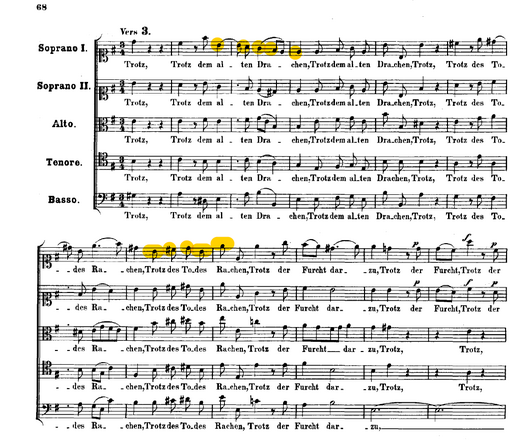Jesu, meine Freude, BWV 227
The text of the motet's even-numbered movements is taken from the eighth chapter of the Epistle to the Romans, a passage that influenced key Lutheran teachings.The hymn, written in the first person with a focus on an emotional bond with Jesus, forms a contrasting expansion of the doctrinal biblical text.Unique in its complex symmetrical structure juxtaposing hymn and biblical texts, and with movements featuring a variety of styles and vocal textures, the motet has been regarded as one of Bach's greatest achievements in the genre.In this context, motets are choral compositions, mostly with a number of independent voices exceeding that of a standard SATB choir, and with German text from the Luther Bible and Lutheran hymns, sometimes in combination.[1][2] In Bach's time, the Lutheran liturgical calendar of the place where he lived indicated the occasions for which music was required in church services.[9] Exceptional compositions with five-part movements can be found in the Magnificat, written in 1723 at the beginning of Bach's tenure in Leipzig, and the Mass in B minor, compiled towards the end of his life.[12][14] The text of Jesu, meine Freude is compiled from two sources: a 1653 hymn of the same name with words by Johann Franck, and Bible verses from Paul's Epistle to the Romans, 8:1–2 and 9–11.[15] The hymn is written in the first person and deals with a believer's bond to Jesus who is addressed as a helper in physical and spiritual distress, and therefore a reason for joy.[16] the melody is built from one motif, the beginning descent of a fifth (catabasis), with the word "Jesu" as the high note, which is immediately inverted (anabasis [de]).[34] According to Bach scholar Richard D. P. Jones, several movements of Jesu, meine Freude show a style too advanced to have been written in 1723.[44] The beginning of the text is rendered in "rhetorical" homophony:[35] Bach accented the word "nichts" (nothing), repeating it twice, with long rests and echo dynamics.[35] The fourth movement sets the second verse from Romans 8, "Denn das Gesetz des Geistes, der da lebendig machet in Christo Jesu, hat mich frei gemacht von dem Gesetz der Sünde und des Todes" (For the law of the Spirit of life in Christ Jesus hath made me free from the law of sin and death.).[53]The central sixth movement sets verse 9 from Romans 8, "Ihr aber seid nicht fleischlich, sondern geistlich" (But ye are not in the flesh, but in the Spirit).[35] It is a double fugue, with a first theme for the first line, another for the second, "so anders Gottes Geist in euch wohnet" (since the Spirit of God lives otherwise in you), before both of them are combined in various ways, parallel and in stretti.[15][55] While the soprano sings the chorale melody, the lower voices intensify the gesture; "weg" (away) is repeated several times in fast succession.[45] The ninth movement is a setting of the fifth stanza of the hymn, "Gute Nacht, o Wesen, das die Welt erlesen" (Good night, existence that cherishes the world).[15][58] For the rejection of everything earthly, Bach composed a chorale fantasia, with the cantus firmus in the alto voice and repetition of "Gute Nacht" in the two sopranos and the tenor.[63] The motet ends with the same four-part setting as the first movement, with the last stanza of the hymn as lyrics, "Weicht, ihr Trauergeister" (Flee, you mournful spirits).[15][41][64] The final line repeats the beginning on the same melody: "Dennoch bleibst du auch im Leide, / Jesu, meine Freude" (You stay with me even in sorrow, / Jesus, my joy).[15] Jesu, meine Freude is unique in Bach's work in its complex symmetrical structure, which juxtaposes hymn and Bible text.[65][66] Wolff summarised: This diversified structure of five-, four-, and three-part movements, with shifting configurations of voices and a highly interpretive word-tone relationship throughout, wisely and sensibly combines choral exercise with theological education.[79] The optimum size of the choir in this work continues to be discussed to this day, for example in reviews of Philippe Herreweghe's one voice per part recordings of 1985 and 2010.
J. S. BachE minorJesu, meine FreudeJohann Sebastian BachBach's motetsmovementsLutheran hymnJohann Franckstanzashymn tuneJohann Crügerchorale settingsthe eighth chapterEpistle to the RomansLutheranchorale harmonisationschorale fantasiamotifsword paintingtheologicalLeipzigChristoph WolffDietel manuscripthistorically informed performancesbasso continuocolla parteProtestantThuringiaBach familymotetsAltbachisches ArchivLuther BibleLutheran hymnschorale tunehis motetsPhilipp SpittaJohann Michael BachABA I, 10E minorLutheran liturgical calendarhis church cantatasMagnificatMass in B minorPraxis pietatis melicaCatherine Winkworthbar formAllemandeNeu Leipziger Gesangbuchcommon timecatabasisBernhard Friedrich RichterThomaskantorCambridge UniversityFriedrich SmendmusicologistSt John PassionSt Matthew Passioncantus firmusBach's Weimar periodJohn Eliot GardinerBach Cantata PilgrimageThomanerchorSinget dem Herrn ein neues Lied, BWV 225Richard D. P. JonesDer Geist hilft unser Schwachheit auf, BWV 226sopranofugal writingincipittime signatureG majorC majorA minorhomophonyJohann ChristophG majorparallel thirdsdramatic illustrationunisonCranachGrünewaldMartin LuthermelismastrettiC majorSarabandePartita No. 3, BWV 827autographchorale harmonisations by BachCarl Philipp Emanuel BachBreitkopfBreitkopf & HärtelBach-Gesellschaft AusgabeFranz WüllnerMotets by Johann Sebastian Bach, discographyBach ChoirRalph Vaughan WilliamsCharles Kennedy ScottPhilippe Herrewegheone voice per partCollegium Vocale GentLa Chapelle RoyaleHarry Christophersthe SixteenMasaaki SuzukiBach Collegium JapanMonteverdi ChoirNew Bach EditionKonrad AmelnBärenreiterKlaus HofmannCarus-VerlagGünter GraulichUwe WolfBach DigitalBach ArchiveGramophoneDürr, AlfredBach Werke Verzeichnis: Kleine Ausgabe – Nach der von Wolfgang Schmieder vorgelegten 2. AusgabeJones, Richard D. P.Oxford University PressGardiner, John EliotGraulich, GünterWolf, UweUrtextCourier CorporationHofmann, Klaus
